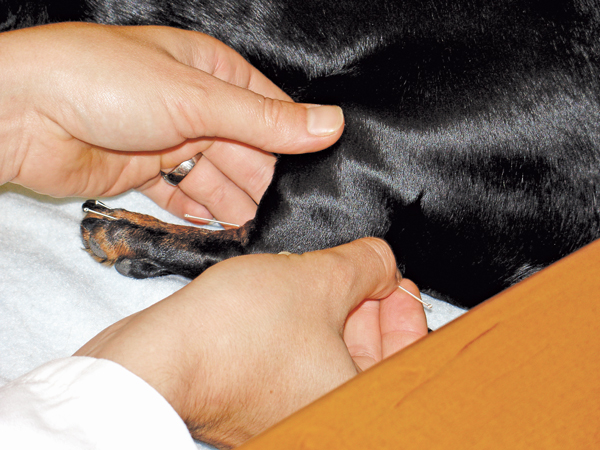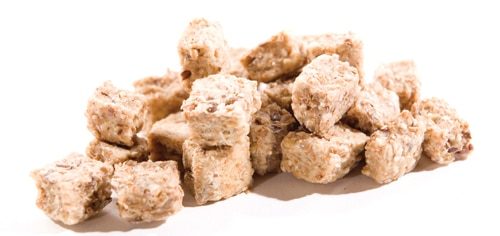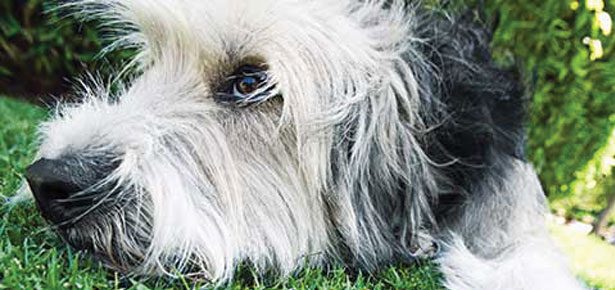

How Chiropractic, Acupuncture & Massage Therapy Can Dramatically Improve Your Dog’s Life
Alternative therapies are increasingly being used to offer relief & even restore the mobility of dogs suffering chronic conditions
Is your dog in pain? Maybe you haven’t considered it before but alternative, holistic treatments like acupuncture, massage therapy, and chiropratic are increasingly being used to solve a whole host of canine problems.
Once the preserve of humans patients, these age-old therapies with New Age panache are steadily encroaching into the animal kingdom. Some of the success stories are so astounding they may make a willing participant of even the staunchest Western medicine adherent.
Dr. Laurie McCauley, a veterinarian who has a string of accreditations after her name attesting to her expertise in acupuncture and chiropractic, has used the 2,000-year-old healing art of acupuncture to treat everything from skin problems to muscular-skeletal pain to neurological issues.
“It’s also huge for paralysis,” explained Laurie, who now works out of North Carolina. Specifically, she cites the case of a little white Bichon who was paralyzed in the back end.
“He couldn’t stand. He was incontinent. We put needles in and literally when we pulled the needles out, he was able to stand and take steps.” The following day, after another acupuncture treatment, he was trotting.
Her chiro successes are no less amazing.
She cites the case of a Cairn Terrier named Murray who, at 14 years old, was still highly competitive in the sport of agility. When she saw him at a dog show, he refused to do several jumps during a run. One look told Laurie pain was at the root of his refusal.
She treated his back problem with chiro and the very next day he came in first among the jumpers and was well ahead of the pack in other areas too.
For the lay person, chiro involves manipulation of the spine and muscles to bring them back into normal alignment while acupuncture involves inserting tiny needles into various points along major channels in the body. If these healing modalities work for humans, why not for dogs?
Laurie generally recommends an integrative approach using both eastern and western medicine so you get the best of both worlds.
And despite the amazing successes she’s seen, she cautions her clients not to expect miracles.
“I always tell people I have the initials DVM after my name, not G.O.D., so I can’t make their dogs live forever—but I can certainly improve their quality of life.”
Josee Gerard, based in Calgary, Alta., is another chiropractor specializing in animal treatment. Although not a veterinarian herself, animals are often referred to her by their vets.
Dogs make up the majority of her practice, although she has treated cows, llamas, deer, birds, rabbits, and even the odd lizard.
Like the other animal healers in this article, she raves about the results. For example, by adjusting the third lumbar spinal nerve, she has managed to restore signals to the bladder to cure urinary incontinence. Simply by repositioning a disc, she says she has managed to cure paralysis.
“It’s the best job in the world for me because sometimes we see an immediate reaction. It’s so rewarding.”
She offers two telltale signs that a dog could benefit from a chiropractor. One of when a dog is attempting to do a full-body shake after emerging, say, from the water and the shake stops before reaching the tail. The second sign is when you are running your hand down the dog’s spine and you see little flinches. Both indicate a blockage in the spine.
Josee charges $120 plus tax for an initial visit, which usually last about 45 minutes, and $50 plus tax for follow-up visits, which usually last about 15 minutes.
Dr. Rachel Barrack, a veterinarian certified in veterinary acupuncture and Chinese herbal medicine, travels around New York City with her duffel bag—filled mostly with tiny needles–treating furry members of the family.
“It has been a wonderful adjunct and has completely changed the way I practice medicine.”
Rachel, whose services start at $200 depending on location and travel, loves nothing more than getting a follow up call from a dog owner saying their pet is running around once again like a puppy.
Acupuncture can help with behavioural problems too. It “can be very calming for dogs with anxiety,” Rachel explains.
The needles are so tiny that most dogs don’t feel any pain when they are inserted. In fact, many dogs even fall asleep during the treatment.
And while western medicine has its benefits, particularly when surgery or advanced diagnostics for acute diseases are required, Rachel has found acupuncture and Chinese herbal medicine seem to be able to tackle chronic conditions like skin disease or prolonged gastro-intestinal issues that can elude standard western medicine approaches.
She’s also found the two can neatly be used in combination. For example, Rachel has found that Chinese herbal therapy and acupuncture can be used to alleviate some of the negative side effects of western drugs, particularly chemotherapy or radiation.
No less promising are the effects of another alternative form of treating dogs: massage therapy.
Denise Theobald used to provide massage therapy for humans. Then one day, while sitting on her back porch with a friend and watching three dogs run around like crazy, she got the idea of extending this healing art to animals.
Now the owner and lead instructor at the Chicago School of Canine Massage, she’s never looked back.
When dogs are brought in lacking mobility because of arthritis or some form of joint dysfunction, she puts those trusty hands of hers to work, massaging deeply into the soft tissue, releasing fascia trigger points.
She uses lymphatic massage as well to stimulate the immune system and decrease primary and secondary swelling.
One of her biggest challenges is building trust with dogs who are in pain so they will allow her to touch them. She works with these dogs gradually, allowing them to experience bit by bit the pain relief that comes with her magic touch. With this positive reinforcement, the reluctance vanishes.
“We can take a dog that is absolutely terrified of people and within a few sessions, they are coming and laying down, accepting massage.”
She has witnessed mini miracles as a result of her healing art. She cites the case of one dog brought in in a cart, a spinal injury preventing him from moving his back end. Through massage, she was able to re-establish a nerve motor pattern and within two months, the dog had 70 to 80 percent more function and was able to bear weight on his own legs.
Denise charges $50 to $80 for roughly a one hour, in-office session, although in the case of palliative or hospice care where the dog can’t withstand a lot of bodywork, she’ll do a half hour session for between $30 to $40.
So whether or not you believe wholeheartedly in these alternative treatments, you might want to give them a whirl.
The successes seen indicate they just might work for your dog, too.
Join the newsletter and never miss out on dog content again!
"*" indicates required fields
By clicking the arrow, you agree to our web Terms of Use and Privacy & Cookie Policy. Easy unsubscribe links are provided in every email.






